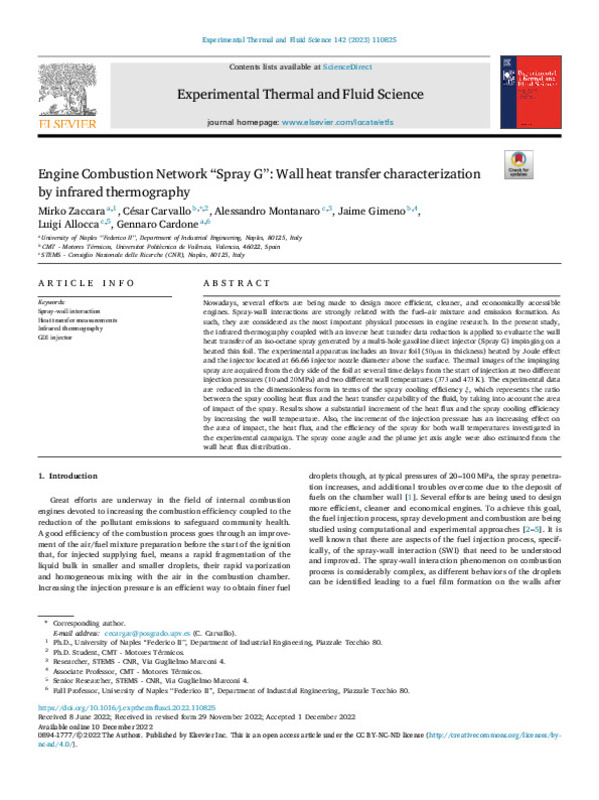JavaScript is disabled for your browser. Some features of this site may not work without it.
Buscar en RiuNet
Listar
Mi cuenta
Estadísticas
Ayuda RiuNet
Admin. UPV
Engine Combustion Network "Spray G": Wall heat transfer characterization by infrared thermography
Mostrar el registro sencillo del ítem
Ficheros en el ítem
| dc.contributor.author | Zaccara, Mirko
|
es_ES |
| dc.contributor.author | Carvallo-García, César Leonardo
|
es_ES |
| dc.contributor.author | Montanaro, Alessandro
|
es_ES |
| dc.contributor.author | Gimeno, Jaime
|
es_ES |
| dc.contributor.author | Allocca, Luigi
|
es_ES |
| dc.contributor.author | Cardone, Gennaro
|
es_ES |
| dc.date.accessioned | 2024-04-11T07:38:19Z | |
| dc.date.available | 2024-04-11T07:38:19Z | |
| dc.date.issued | 2022-12 | es_ES |
| dc.identifier.issn | 0894-1777 | es_ES |
| dc.identifier.uri | http://hdl.handle.net/10251/203317 | |
| dc.description.abstract | [EN] Nowadays, several efforts are being made to design more efficient, cleaner, and economically accessible engines. Spray-wall interactions are strongly related with the fuel-air mixture and emission formation. As such, they are considered as the most important physical processes in engine research. In the present study, the infrared thermography coupled with an inverse heat transfer data reduction is applied to evaluate the wall heat transfer of an iso-octane spray generated by a multi-hole gasoline direct injector (Spray G) impinging on a heated thin foil. The experimental apparatus includes an Invar foil (50 mu m in thickness) heated by Joule effect and the injector located at 66.66 injector nozzle diameter above the surface. Thermal images of the impinging spray are acquired from the dry side of the foil at several time delays from the start of injection at two different injection pressures (10 and 20 MPa) and two different wall temperatures (373 and 473 K). The experimental data are reduced in the dimensionless form in terms of the spray cooling efficiency zeta, which represents the ratio between the spray cooling heat flux and the heat transfer capability of the fluid, by taking into account the area of impact of the spray. Results show a substantial increment of the heat flux and the spray cooling efficiency by increasing the wall temperature. Also, the increment of the injection pressure has an increasing effect on the area of impact, the heat flux, and the efficiency of the spray for both wall temperatures investigated in the experimental campaign. The spray cone angle and the plume jet axis angle were also estimated from the wall heat flux distribution. | es_ES |
| dc.description.sponsorship | The author C. Carvallo thanks the Universitat Politecnica de Valencia for his predoctoral contract (FPI-2019- S1) which is included within the framework of Programa de Apoyo para la Investigacion y Desarrollo(PAID-01-19) and would also like to say thanks for the mobility economical help provided by the program Ayudas para movilidad dentro del Programa para la Formacion de Personal investigador (FPI) de laUPV''.The authors kindly acknowledge Consiglio Nazionale delle Ricerche- STEMS for hardware and technical support. Funding for open access charge: CRUE-Universitat Politecnica deValencia. | es_ES |
| dc.language | Inglés | es_ES |
| dc.publisher | Elsevier | es_ES |
| dc.relation.ispartof | Experimental Thermal and Fluid Science | es_ES |
| dc.rights | Reconocimiento - No comercial - Sin obra derivada (by-nc-nd) | es_ES |
| dc.subject | Spray-wall interaction | es_ES |
| dc.subject | Heat transfer measurements | es_ES |
| dc.subject | Infrared thermography | es_ES |
| dc.subject | GDI injector | es_ES |
| dc.subject.classification | MAQUINAS Y MOTORES TERMICOS | es_ES |
| dc.title | Engine Combustion Network "Spray G": Wall heat transfer characterization by infrared thermography | es_ES |
| dc.type | Artículo | es_ES |
| dc.identifier.doi | 10.1016/j.expthermflusci.2022.110825 | es_ES |
| dc.relation.projectID | info:eu-repo/grantAgreement/UPV-VIN//PAID-01-19-17//Estudio experimental del comportamiento de chorros de inyección directa de gasolina GDI durante el impacto contra una pared en condiciones realistas de motor. / | es_ES |
| dc.relation.projectID | info:eu-repo/grantAgreement/UPV//FPI 2019 S1/ | es_ES |
| dc.rights.accessRights | Abierto | es_ES |
| dc.contributor.affiliation | Universitat Politècnica de València. Escuela Técnica Superior de Ingenieros Industriales - Escola Tècnica Superior d'Enginyers Industrials | es_ES |
| dc.description.bibliographicCitation | Zaccara, M.; Carvallo-García, CL.; Montanaro, A.; Gimeno, J.; Allocca, L.; Cardone, G. (2022). Engine Combustion Network "Spray G": Wall heat transfer characterization by infrared thermography. Experimental Thermal and Fluid Science. 142. https://doi.org/10.1016/j.expthermflusci.2022.110825 | es_ES |
| dc.description.accrualMethod | S | es_ES |
| dc.relation.publisherversion | https://doi.org/10.1016/j.expthermflusci.2022.110825 | es_ES |
| dc.type.version | info:eu-repo/semantics/publishedVersion | es_ES |
| dc.description.volume | 142 | es_ES |
| dc.relation.pasarela | S\479431 | es_ES |
| dc.contributor.funder | UNIVERSIDAD POLITECNICA DE VALENCIA | es_ES |
| dc.contributor.funder | Universitat Politècnica de València | es_ES |








